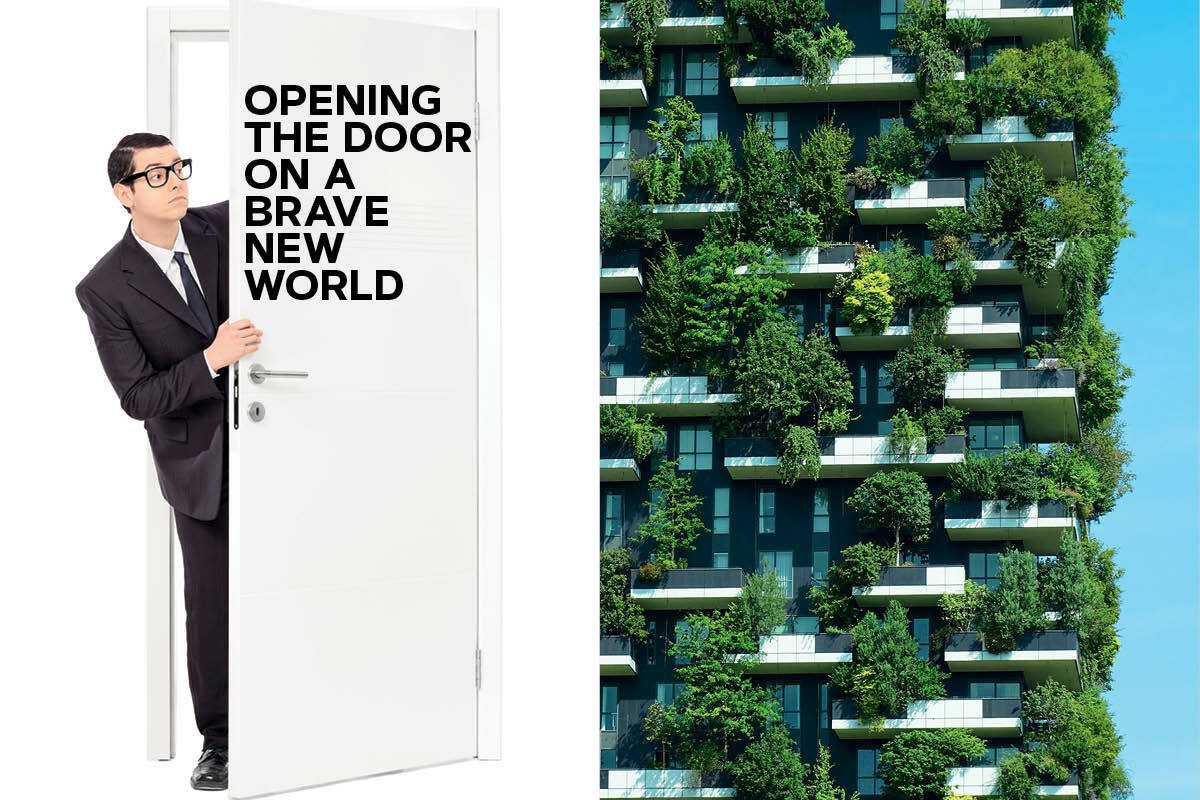
Opening The Door On A Brave New World
As the population soars, New Zealand’s cities and homes will have to adapt as will investors and landlords. Sally Lindsay explores what this means.
24 October 2023
One hundred years in the future houses will be, in almost all respects, semi-living, artificial organisms – closed systems with a metabolism, sensory apparatus, immune response and an approximation to a nervous system.
Interior living spaces will change as a cloud changes, easily reconfigured and rearranged to suit our fickle tastes, or accommodate different purposes.
Imagine walls and floors made of a malleable skin and embedded with tiny sensors and actuators so the shape and size of living spaces can quickly change, or even be divided into smaller rooms.
This barely scratches the surface. Imagine homes with a building material salted with dormant limestone-producing bacteria which awaken on contact with moisture and repair a crack or structural damage.
That is a futurist’s utopia of how most of the globe’s population will live, but Kiwis are still living in mainly old villas from the early 1900s, 1950-1960’s mid-century houses, more modern plaster-clad homes and a growing number of townhouses and apartments.
There are no suggestions as radical as a Mexico architecture firm’s idea of subterranean earthscrapers extending 65 storeys into the earth to fix what many see as New Zealand’s housing crisis – not enough houses, not enough that are affordable, not enough rentals and a huge social housing waiting list. So, what is the future for housing here?

Build-To-Rent
One of the most talked about additions to the country’s housing market is build-to-rent.
More than 600,000 homes sit in the rental pool across the country and build-to-rent companies aim to increase that number by thousands over the coming 10 to 20 years to help the rising numbers of people who cannot afford or don’t want to own a home.
Backed by institutional investors, build-to-rent is an accepted form of living overseas, whereas it is in its infancy in New Zealand. One of Germany’s biggest dedicated rental housing companies, for example, has 300,000 properties.
Sam Stubbs, a KiwiSaver market disrupter, and builder Shane Brearley have plans to out-build Kainga Ora, which has 60,000 state houses, through their company Simplicity Living, which builds to own forever and to rent out at below market rates.
“Build-to-rent is a housing option long missing in New Zealand, but it’s time is coming,” Stubbs says.
The developer is targeting 10,000 or more new professionally managed homes across the country over the next decade. So far it has completed 159 homes and will have another 345 under construction by Christmas. There are another 800-plus in development and planning.
“We are going for scale,” Stubbs says. “Only increased housing supply will solve the country’s housing problems. We think New Zealanders can fix the problem by not thinking of large-scale efficiently built developments as ‘cookie cutter’ and thinking of them as a practical, attractive solution to a real problem.”
While there have been calls for changes to Overseas Investment Office rules to allow foreign build-to-rent capital and expertise into NZ, he isn’t convinced lack of money is the real problem. “The real issue is housing affordability, and more money will not necessarily make homes cheaper to build and more affordable. The real challenges are land, consenting and build capacity.”

Simplicity Living’s Oranga Apartments in Onehunga – completed earlier this year.
Pioneering Player
Since 2014, New Ground Capital has been pioneering the development of build-to-rent housing for institutional investors, at the same time as offering tenants up to 10-year leases, the ability to do minor alterations and possibly keep a pet.
Building at the higher end of the scale, one of New Ground Capital’s first projects was the 2018 completion of 47 terraced rental homes at Whenuapai for the NZ Defence Force.
Since then, it has built 47 apartments at Hobsonville, 50 apartments at Tamaki in Auckland and has 44 homes at Mt Albert, Auckland, finishing progressively this year and next as well as 45 houses at Otumoetai, Tauranga, available next year.
New Ground also has a site with Kainga Ora in Mangere, Auckland, for build-to-rent housing that was to be finished this year. It has a big waiting list for its new rentals.
Co-founder Roy Thompson says even if build-to-rent makes up 5 per cent of the housing market over the next 10-15 years that’s an “awful lot of housing”.
His company works with local investors, such as the New Zealand Super Fund, iwi and community trusts for investment capital and believes the OIO rules should be changed to allow foreign capital to invest.
“Large overseas institutions are mature, patient and stable sources of capital for build-to-rent housing. They also bring decades of expertise, the latest in housing innovation and designs that 99 per cent of Kiwis would dream of living in. Local investors are just getting their minds around what build-to-rent housing actually is and they’re just not yet prepared to commit sufficiently large amounts of capital.”
He says build-to-rent is not a natural market for mum and dad investors and the reason is timeframes. “We give tenants long-term tenure, which means we can’t terminate the leases within 10 years unless there is a breach. For mum and dad investors that is the opposite of what they are looking for – they want the ability to get their investment money back at short notice.”
Thompson says that is one of the major problems with the country’s rental market. “It is dominated by mum and dad investors, and they want to hold all the options. It creates a tenuous existence for rental households and that’s what we can totally change with our model.”
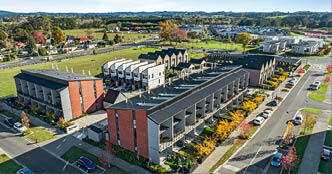
NGC Houkura NZDF rental housing in Whenuapai.

Moroki rental apartments in Glen Innes – a NGC development.
Compact, Modular
While more houses go up, they are becoming smaller. Stats NZ figures show in the past five years all new consented houses shrank in average size from 172m2 to 150m2. In the not-too-distant future, they could become smaller with fold-down and fold-away furniture manufactured specifically to fit them.
Already, some NZ developers are shipping in totally completed apartments, hotel rooms and other buildings and stacking them beside or on top of each other to make up new complexes.
Thompson doesn’t believe it is the right way to go. “We grow all this wonderful timber, and we should be using that to construct homes in the most sustainable way possible, rather than importing essentially air labour and steel from China in the form of modular housing. It’s totally unsustainable. What we really should be focused on is making our timber-based construction industry more efficient, rather than trying to find solutions in China.”
Property Investors’ Federation president Sue Harrison says there is a bigger picture to consider. “There’s a tsunami of people moving around the world because of climate change and that’s going to intensify into New Zealand and Australia no matter what we do. So we should be planning for that now, preparing for it in terms of overall housing.
“Politicians need to look at private/public partnerships and engage with people who are both suppliers and users of homes,” she says. “City intensification will be needed along with compact homes. It’s got to happen whether we like it or not, but it’s about doing it the right way and planning it well.”
New housing, no matter what type, needs to go up and be planned around existing infrastructure, although Harrison says plenty of existing housing can be upgraded perfectly well without throwing away the key.
CoreLogic research head Nick Goodall agrees with Harrison and says the country’s cities need more dense living. “We are just starting to move towards that. Australia’s New South Wales, for example, has been building more units than houses for 20 years. Obviously, investment in infrastructure is needed to go alongside that so more people can be housed in smaller spaces.”
He says while there is probably still, and will be, a preference for living in standalone houses, once realism kicks in and people understand that’s not viable because of the cost, especially as a first home, expectations adjust. The share of townhouses has increased dramatically over the past few years at the expense of big standalone houses.
“The sacrifice of moving to a townhouse rather than a standalone house is probably one of the easier ones to forego, especially if it means people are just getting on the property ladder.”
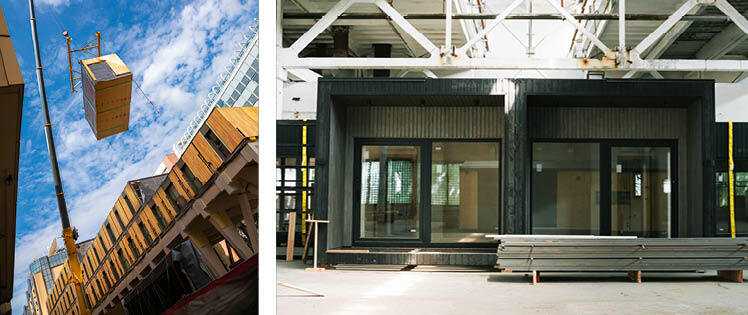
Stackable prefab apartments, hotel rooms and other buildings are already being shipped in.
Coastal Scene
For the well-heeled having a house or bach on the coast has been an attainable dream until recently.
Ironically, some of the property that fetches the higher prices in NZ is most at risk of rising sea levels, and that will probably lead to insurance being unavailable or cut in the future.
After the Auckland Anniversary weekend flooding in January, and Cyclone Gabrielle in February, the country’s largest insurer, IAG, says it will not issue new insurance policies on flood-prone and landslip-threatened homes categorised as either 2 or 3 after the government and local councils introduced land zoning for areas affected by flooding. It follows a similar announcement from Suncorp.
IAG says, however, cover will continue until owners have their homes bought out in a managed retreat scheme being created by local councils and the government, or they refuse a buyout offer.
Insurance advisers say the tipping point has arrived regarding a large insurer starting on a large-scale retreat of insurance cover for these risk-prone areas.
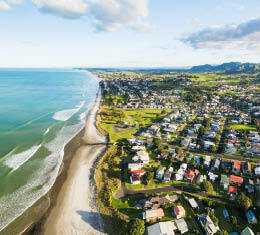
Some of the highest priced property in NZ is on coastal land at risk of flooding.
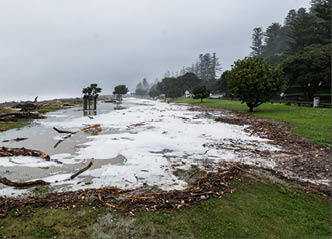
Napier feeling the effects of Cyclone Gabrielle in February.
The Big Picture
Many people looking for answers to the common problem of housing shortages believe modern construction peaked with computer-aided design, but American firm Apis Cor completed a new Stupino, Moscow home in a day for only NZ$20,000 using mobile 3D printing technology. The completed construction, including interior, took less than 24 hours for an open plan studio-style home, measuring 37m2.
That is one of the biggest advancements in house building in decades.
Also on the horizon are design concepts like earthscrapers, groundscrapers and oceanscrapers. They have emerged as possible building alternatives to counteract cramped urban spaces.
Earthscrapers begin at the surface and extend downwards just like a skyscraper extends upwards, while underground structures like car parking or a few levels of a shopping centre already exist around the world, they are not the same as earthscrapers.
Then there’s SAM the bricklaying robot. Designed to operate collaboratively with a mason, it can work six times faster than a human, laying 3,000 bricks a day.
Drones have made their way on to the building site too, with Japanese construction giant Komatsu using them as “the eyes” for automated bulldozers. The drones scan the site and feed information to machines to plot a course.
On the material spectrum, there are plastic bricks. A Danish student has developed the concept of recycling the plastic bags that dominate India’s landfills and turned them into bricks. The colourful bricks can withstand up to six tonnes of pressure and are likely to hold up better than clay brick homes.

New technology continues to improve and streamline building processes.


